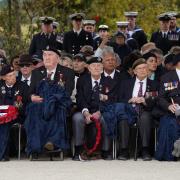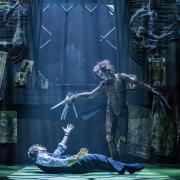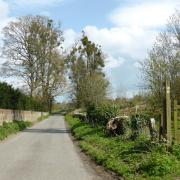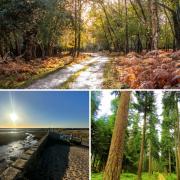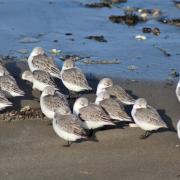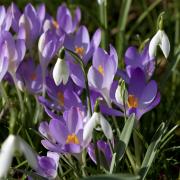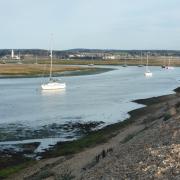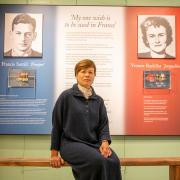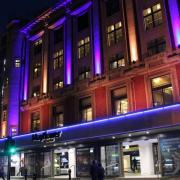Embarking on an arty version of an Easter egg hunt, Carole Varley discovers the fascinating town of Alton on their sculpture trail

“I wonder if the name Alton is a corruption of the words old town,” my husband said to me, on our journey back through the undulating Hampshire countryside after a visit to this ancient market town. It seemed very likely, given the quaint names and cobblestone nature of some of the lanes and courtyards we had been exploring there, such as Mechanics Alley and Cross and Pillory Lane, which smacked so redolently of life in the Middle Ages.
However, it would seem that Alton has an even older derivation, coming from the Anglo-Saxon word aewielltun, meaning ‘farmstead at the source of the river’ (the Wey, in this case). It turns out that there was a Saxon settlement in the area, and the Alton Buckle, which is often considered to be the finest piece of Anglo Saxon craftsmanship found in Hampshire, has found a home in the town’s Curtis Museum.
We weren’t there to look at such ancient crafts, however. No, today we had come to Alton to inspect more recent artefacts, such as a bandstand, wall plaques and a children’s climbing frame, all of which feature on the Alton Sculpture Trail, whose origins are obscure, but are thought to have been the brainchild of one of the former curators of the town’s Allen Gallery.
The trail starts at the top of the town, at the Railway Arms public house, and the sculpture in question here is a small steam engine, looking much like one you might see in a Thomas the Tank Engine book, bursting out of the wall. It’s very apt for Alton, as the pub is just down the road from the station where the famous Watercress Line runs to Alresford, regularly attracting steam train aficionados from all over the world. The train sculpture was created in 2003 by artist Richard Farrington, apparently inspired by Belgian impressionist Rene Magritte’s painting ‘Time Transfixed’.
It is highly likely that the casual visitor would give this sculpture a second glance, but I’m not so sure they would the next few items on the list, such as the carved stone on the side of the Telephone Exchange bearing the date 1936, or the freestanding post box just a little further down the road.
Still, bearing aloft the sculpture trail notes that we had downloaded from the website (www.alton-sculpture-trail.hampshire.org.uk) - they come with snippets of information such as when, why or by whom the objects were built - we were invited to look again at such everyday items from the viewpoint of their use and usefulness, and how they manipulated the environment around them.
Other artefacts stood out as more obvious candidates for the trail, like the granite cairn structure in Crown Close, which was built in 1920 to commemorate the sacrifice of the soldiers of the First World War, and Mark Coreth’s large bronze sculpture of a bear, installed in 2005 in the Westbrook Walk arcade - the significance of which, however, appears to have eluded most of the townsfolk I spoke to.
Brackets bearing signs hanging outside shops, terracotta tiles, the clock outside a travel shop that once used to be a watchmaker’s (time still being of the essence, no doubt) and a 200-year-old boot scraper were among the eclectic mix of items we might normally have walked straight past. Indeed, the very act of locating the ‘sculptures’ was, like some kind of adult Easter egg hunt, interesting in itself, as it was through this that we also serendipitously got to see Alton’s ancient nooks and crannies and the building that once housed the bank part-owned by Jane Austen’s brother Henry. Indeed, as the nearest town to Austen’s home in nearby Chawton, we discovered that many of Alton’s buildings have associations with the celebrated author, including that of her doctor, William Curtis, whom she called her ‘Alton Apothy’.
Getting back on track though, the trail next brought us to the Grade-I listed St Lawrence Church, whose origins lie in the Norman period and which is notable for it being the site of the concluding action of the Battle of Alton during the English Civil War. Here there was a feast of medieval crosiers (shepherd’s crooks), 15th-century corbels, animal-carved pillars and a pulpit fashioned from decorative woodwork; not to mention the marble doves and angels in the cemetery, to examine.
By the time we arrived at the apotheosis of the trail, the Allen Gallery, which boasts a wide collection of art works, including one by world-famous sculptor Jacob Epstein, we felt as though our perceptions had been re-forged in a baptism of sculptural fire. As the trail sets out to prove, there are journeys of discovery to be made down even the smallest streets, whether you are out to sink a pint or just post a letter.
-------------------------------------------------------
Did you know?
Roger Burnett’s life-size sculpture of dancing girls in the garden of the Allen Gallery was based on his two daughters Tania and Trina dancing in a field. The Yorkshire-based sculptor had been visiting a nearby foundry and, after a discussion with gallery staff, it was decided to hold an exhibition of Burnett’s work with this piece being created specifically for it.
Dolores by American sculptor Sir Jacob Epstein (1880-1959) was known for his bronze sculptures of females, including his wife, mistress and a host of Bohemian characters, such as former singer and dancer Dolores. The large spiky earring is a particular feature and she said in an interview in 1930 that Epstein thought ears were the most important adjunct to a woman’s beauty. The sculptor made four different studies of Dolores in 1923 and the one in the Allen Gallery is from the third casting plaster and known as the ‘bust with crossed arms’. It was described by Epstein himself as “tragic and agnificent”.
-------------------------------------------------------
Jane Austen trail
This year the world celebrates the 200th anniversary of the publication of Mansfield Park, Jane Austen’s third novel, which she wrote while living at Chawton Cottage, just outside Alton. Visitors can embark on a walking trail that links Chawton to Alton, where she often visited. In Chawton you see many of the sites the Austen family would have known well, including her own home, and Chawton House, where her brother Edward lived and where she was a regular visitor. In Alton there are establishments such as the Swan Inn, where Jane would have taken the coach to visit London, and the houses where many of her friends and acquaintances once provided raw material for her novels. For more information and a map of the trail, visit www.janeaustentrail.org.uk-------------------------------------------------------
Where to stay
St Mary’s Hall offers award-winning - Gold at the Beautiful South Awards for the past three years running -, four-star, bed-and-breakfast accommodation in what was once Alton’s first Catholic Church. Full of unique character, it also has luxurious facilities, with four suites to choose from. Located in a peaceful setting, the town centre is just a few minutes’ walk away. For more details and to book visit www.altonbedandbreakfast.co.uk






